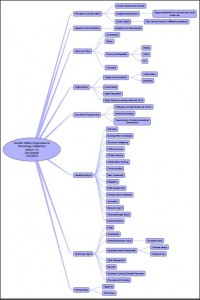Reputation can be defined as people’s perceptions of a person’s character. In the realm of digital space, including social media, reputation is built on 1) the content a person produces or shares (tweets, blog posts, photos, videos, …) and their interactions with others (digital footprint) and 2) what others share about a person (digital shadow). Eric Qualman coins the terms digital footprint and digital shadow.
This post is about some of the benefits I’ve received by having an intentional digital presence through my blog, Twitter, LinkedIn, Instagram, Pinterest, Goodreads, Slideshare, and Facebook. When I joined the social media platforms I mentioned a few years ago, I could never have imagined the folks I would meet, which led to professional collaborations and opportunities that have come my way. I’ve also developed some friendships along the way. I share the following list to illustrate how a person such as myself, who, in my opinion, is no different than most folks in my professions (student affairs, higher ed IT), can benefit from having a positive presence online.
- Elected as NASPA Technology Knowledge Community Chair (2017-2019).
- Hired as a consultant by two universities to lead an external program review team.
- Co-present sessions on social media at a couple of conferences.
- Invitation to NASPA Technology Summit in Washington, DC.
- Invitation to contribute an article to NASPA Leadership Exchange Magazine.
- Invitation to co-author a chapter on Student Affairs technology.
- Accepted as an assessor to a UC Leadership program based on my blog posts about leadership.
- Invitation to speak to student affairs grad students on digital reputation.
- Invitation to be a guest on a podcast to talk about student affairs technology.
- Opportunities to speak on digital reputation and alternative professional development for multiple groups at UCSB.
When I share my perspectives online, I’m not always sure how others receive my message. Even with the best and clear intentions, my messages are received in many ways. Given that realization, I’ve developed principles that guide how I present myself and interact with others online. Some of my main principles include:
- Be honest.
When folks, including my Vice Chancellor for Student Affairs, our campus CIO, my colleagues, students, my family and friends, and other professionals I respect follow me on social media, I better be consistent and honest with what I share.
- Be kind in how you relate with others.
Even when I’ve disagreed with others, I always try to maintain respect as I would like to be treated with the same kindness. One of the limitations of social media is that one does not get the full context of what is being shared or how a person may act.
- Aim to provide value to others.
I started primarily writing about my personal and professional interests with my blog. I’ve found my blog to release my frustrations related to my experience as a person of color and share my visions of what I think student affairs and technology may hold in the future. While I still primarily write for myself, I’ve found that others do relate to the topics I write about. I get messages from folks who tell me how a blog post prompted them to re-frame their thoughts or how they can relate to my experience, specifically about racism and discrimination.
Another way I’ve found myself to be of value is by connecting folks from different circles of my life. Just like I do in conferences or parties, it’s fun to be able to introduce friends and colleagues who may share interests and then gently step away so they can have the space to continue the conversation themselves.
I do have some missteps from time to time, and I don’t always follow my principles; I’m human, but I strive to apply the principles I mentioned above.
I hope my post has convinced you (if not already) that building/maintaining a positive digital presence does have some benefits. Please let me know if I could provide you with some ideas on getting started.
How about you? How are you managing your digital presence, and what principles do you use?


